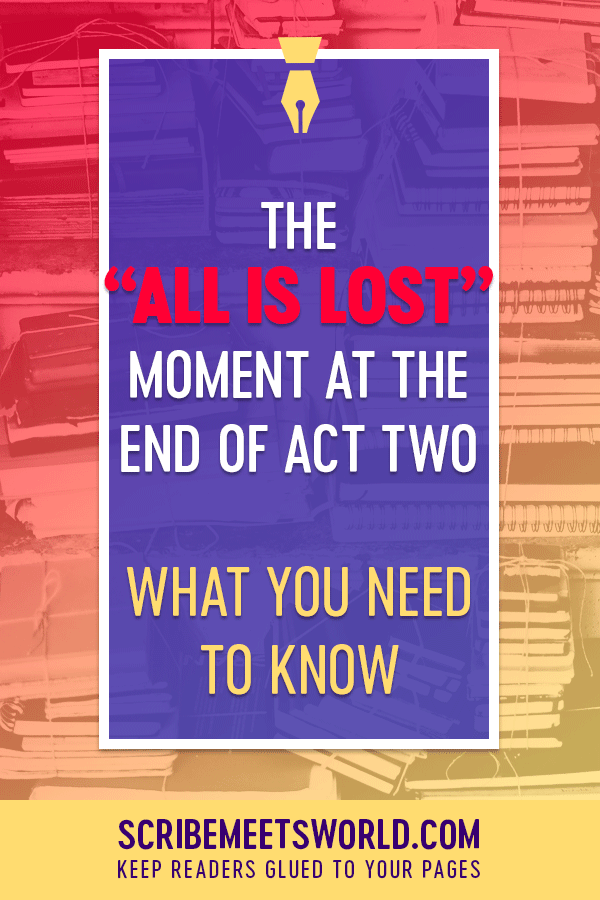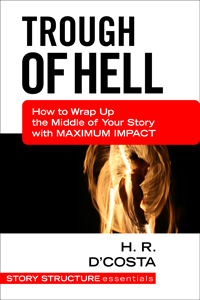Question for you:
Between the beginning, middle, and end of your story, which is the hardest to write?
The middle, right?
The middle of your story (a.k.a. Act Two) stretches out like a vast expanse of blank pages.
Blank pages?
They’re scary in general.
But blank pages from Act Two?
They’re downright terrifying.
Why is that?
Well, when you start to write the beginning of your story, you were full of ideas. You were able to cruise right through it.
But then, when it came to the middle…you run out of steam.
You have no idea of what happens next, no idea of how to go forward.
In short, you hit a wall.
That’s why the middle of a story is so terrifying. It’s where you’re most likely to abandon your draft.
Fortunately, there is a simple solution to get yourself out of this sticky situation: use story structure to your advantage.
To be more specific, figure out these key structural turning points in advance:
- midpoint (which, as its name implies, occurs halfway through your story)
- “all is lost” moment (which occurs at the very end of Act Two)
Do you see how this will make a huge difference? Now you have two major markers to guide your path as you write.
You don’t have to come up with enough words to fill up 60 blank pages. (If you’re a novelist, see the special note five paragraphs down.)
You just have to write 30 pages that culminate in the midpoint, and then 30 pages that culminate in the “all is lost” moment.
That doesn’t sound so bad, right?
It feels much more doable.
Much.
A special note for novelists: this article was originally written for screenwriters. However, the points in it apply to novels too, not just screenplays. Ignore the reference to page numbers, and you’ll be all set.
Anyway, with these two structural markers in hand, you’ll know where you’re headed. You’ll be a lot less likely to give up on your story halfway through it.
So, now you’re probably wondering how to come up with a midpoint and an “all is lost” moment that’ll work for your story.
I’ll explain everything after the jump. So stay with me and scroll down!
ARE YOU ON PINTEREST? Save the image below to one of your boards on Writing, Plotting, Story Structure, or Screenwriting. (When you hover over the image, a Pinterest save button will appear in the top-left corner. Click on that to save to Pinterest.)

Finally! A writing article that clearly explains the “all is lost” moment at the end of Act Two
For the midpoint, think of an event that will shake things up and swing your plot in a new direction.
One option is to use something I call the manifest midpoint. It not only shakes things up but also enables you to escalate the conflict in your story (which is notoriously hard to do).
You can also discover two more midpoints by previewing Lesson 2.1 from my online course on story structure.
And if you want a full set of options—eight to be exact—then check out my writing guide Midpoint Magic.
But that’s enough about the midpoint. We’ve got to move on to the main attraction, what this writing article is really about—the “all is lost” moment.
What’s the key to creating the perfect Act Two ending?
Craft a painful, emotionally charged series of scenes that somehow brings your protagonist closer to his goal…even though, on the surface, he appears to be the furthest from it.
In sum, the secret to nailing the “all is lost” moment is to combine these three essentials:
- pain
- emotion
- paradox
Basically, they’re all you need to create a second-act ending that’s effective and powerful.
One with the capacity to re-engage audiences, right when their interest usually flags. (Actually, that’s another reason why it’s important to get this plot point right.)
At this stage, you probably want to dig deeper into each of these “all is lost” essentials.

No problem—I’m happy to share additional writing tips (adapted from my writing guide Trough of Hell – more details at the end of this article).
Ready? Let’s go!
“All Is Lost” Moment – Essential #1: Pain
As a writer, you’re probably inclined to be kind to your protagonist.
After all, he’s usually the character whose essence and history most mirror your own personality and experience.
But you must resist that urge. In the words of Kurt Vonnegut:
Be a sadist. No matter how sweet and innocent your leading characters, make awful things happen to them—in order that the reader may see what they are made of.
While this is true throughout your script, it’s especially true at the end of Act Two, during your protagonist’s “all is lost” moment.
By being cruel to your protagonist, you’re being kind to audiences, who expect to experience a roller coaster of emotions.
The “all is lost” moment is the dip that makes your protagonist’s eventual ascent during Act Three all the more powerful.
In all likelihood, your first set of ideas of how to end Act Two is probably the equivalent of a paper cut. That’s not good enough, not to create an “all is lost” moment with impact.
For that, you need to turn the paper cut into a gaping wound (which, needless to say, is genre appropriate).
And after that…
Throw salt onto your protagonist’s wounds
Unstinting pain, that’s your primary order of business at this stage of your story.
Take Bridesmaids. The screenwriters, Kristen Wiig and Annie Mumolo, created a truly horrendous “all is lost” moment for their heroine, Annie.
At the end of Act Two, Annie:
- is demoted from her position as Lillian’s maid of honor
- wrecks her blossoming romance with Officer Rhodes
- gets fired from her job at the jewelry store
- is ousted from her apartment by her two comedically creepy roommates
- completely ruins her friendship with Lillian
Notably, Kristen Wiig also starred as Annie. Even so, Wiig treated her character with sadistic hands.
When writing and revising your own screenplay, you should follow Wiig’s lead: be merciless to your protagonist.
That’s not to say that you must wound your protagonist on multiple fronts in order to create an effective “all is lost” moment. A single, deep gouge can be equally as powerful.
Look at Speed. At the end of Act Two, Jack Traven experiences only one major loss. But it sure is a doozy.
The death of Jack’s best friend and police partner, Harry, is enough to take Jack out of commission. (At least temporarily.)
Why did this loss pack such an emotional punch?
It was a powerful moment precisely because of the way the action movie portrayed Jack and Harry’s friendship…
…which brings me to…
“All Is Lost” Moment – Essential #2: Emotion
Your protagonist’s “all is lost” moment must elicit some significant degree of emotion from audiences.
Otherwise, it’s about as useful as a flat tire.
As far as emotional reactions go, tears are great, but not always probable. Wide eyes and an involuntary gasp work equally well.
Whether expressed through tears or gasps—or something in between—if successful, your “all is lost” moment recharges audiences’ emotional investment in your protagonist’s success all over again, priming them for the gripping climax that’s just ahead.
Sadly, this is where amateur writers make a fatal mistake
They assume that audiences will automatically care about whatever tragedy befalls the protagonist at the end of Act Two.
But this isn’t the case–even with death.
Whether your protagonist experiences a personal loss or a setback that seriously jeopardizes the stakes, you must show—not tell—audiences how and why this state of affairs matters to your protagonist.
As an example, let’s examine Guy Ritchie’s Sherlock Holmes (2009). Toward the end of the second act, Watson is seriously injured in a factory explosion. Obviously, he’s in a great deal of pain.
But Watson’s suffering doesn’t automatically produce a moment of emotional resonance for audiences. This event has resonance specifically because the film took the time to show audiences how meaningful Watson’s friendship is to Holmes.
Here’s a helpful exercise:
- Watch Sherlock Holmes (2009).
- Write down all the ways it showed audiences Watson’s significance to Holmes.
- Imagine the movie without these small, but critical, details.
Without those details, do you think Watson’s Act Two injuries would’ve had the same emotional effect?
Really?
Even if your protagonist experiences a setback that puts an entire city, country, planet, or galaxy into serious jeopardy, it’s still imperative to give audiences a reason to care about such tragedy.
As Scott Myers explains in an interview with Script Magazine:
I read a LOT of scripts and one recurring issue I find, regardless of genre, is a lack of emotional resonance. There can be all this huge stuff going on in the plot, literally in a sci-fi story at the scale of blowing up an entire planet, but if there aren’t points of connection for a script reader to the story’s characters, where we actually FEEL something authentic for them, then the effect can be so much noise.
That’s why I have this writing mantra: Substantial Saga / Small Story. That is whatever the big story is, what I call the Plotline, there have to be some intimate subplots and dynamics going on which engender a human connection between the reader and the characters.
Here’s one way to make that human connection that Myers is talking about: build a subplot around a character who comprises the stakes.
For example, if an entire planet will disappear if your protagonist fails to accomplish his goal, then weave in a subplot about fraternal twins trying eke out an existence on this planet.
Another worthwhile option: use a subplot to demonstrate the value of whatever your protagonist loses at the end of Act Two.
This way, your “all is lost” moment will have emotional impact.
This way, you’ll have audiences right where you want them–eating from the palm of your hand.
Well…you will achieve that effect as long as you don’t use deus ex machina—a plot device that audiences loathe—to rescue your protagonist from his “all is lost” moment.
How to fix this problem? Again, a subplot can help you out. For examples on how to use a subplot to eliminate deus ex machina, read this.
Also, if you need help with subplots, you might want to check out a 3-part series I wrote all about subplots on Elizabeth Spann Craig’s blog for writers. Here are the links:
- 5 Uses for Subplots (Part I)
- How to Structure Your Subplots (Part II)
- How to Weave Subplots Into Your Story (Part III)
“All Is Lost” Moment – Essential #3: Paradox
This, perhaps, is the trickiest aspect of the “all is lost” moment to understand.
You and I both know that your story climax is just around the corner. Assuming your story ends on a positive note, your protagonist’s victory is a mere 15 pages away (give or take).
So, then, how can your protagonist be the furthest away from his goal at his “all is lost” moment?
In truth, he’s not. It just looks like he is.
See, oftentimes, your protagonist’s Act Two defeat, as negative and unpleasant as it is, is exactly what your protagonist needs to:
- push past his demons
- give up his crutches
- overcome his innate resistance to change
Because your protagonist has hit rock bottom at the “all is lost” moment, he’s desperate enough to take the path of most resistance—and confront the very thing he was trying to avoid.
In the process, he’ll blossom into the person he was meant to be.
The epic defeat of the “all is lost” moment contains the seeds of lasting victory
If you examine the end of Act Two from this perspective, then success is not as far off as your protagonist imagines—he just has to hang in there a little while longer.
It certainly doesn’t seem that way. Not to your protagonist, and certainly not to audiences.
Therein lies the paradox!
There are multiple ways this paradox can manifest itself. We’ll explore one of them here: the paradox of unfettered growth.
In this type of paradox, the protagonist is typically reliant upon the support of his mentor or on the assets of his employer.
But to vanquish the villain, the protagonist will have to let go.
Like most people, protagonists are often resistant to change, and correspondingly, are reluctant to part ways voluntarily.
At the “all is lost” moment, however, the choice is taken out of the protagonist’s hands.
His mentor might die; his organization might cut him loose.
Either way, although this is a devastating moment for the protagonist, paradoxically, it contains the seeds of future victory.
Star Wars: A New Hope is a classic example. Until Obi-Wan is killed by Darth Vader, Obi-Wan instructs Luke in the ways of the Force. But Obi-Wan won’t always be at hand to fight Luke’s future battles for the restless rebel.
Even though Obi-Wan manages to communicate to Luke from beyond the grave, Luke still has to learn to rely on his own instincts and to refine his mastery of the Force.
As counterintuitive as it may seem, Luke’s development is facilitated by Obi-Wan’s death because this loss forces Luke to grow.
Put another way, Luke’s separation from Obi-Wan in A New Hope helps prepare Luke for the trials he must endure in The Empire Strikes Back and Return of the Jedi.
In the commentary for Return of the Jedi, George Lucas summarizes this idea quite nicely:
There is a point, where the hero has to be left alone, on his own two feet, without anybody there to help him…at some point…all the props have to be taken away, and he has to face the evil monster alone.
That’s the power of the “all is lost” moment.
It forces your protagonist to face the monster all alone—to prove his heroic mettle. And in doing so, he’ll prove he’s worthy of his Act Three reward.
“All is Lost” Moment – Beyond the Basics
There you have it—the three keys to crafting the perfect “all is lost” moment:
- pain
- emotion
- paradox
Now that you know these elements, it should be much easier for you to figure out how to end Act Two of your screenplay.
By the way, the “all is lost” moment goes by many names. You may’ve heard it referred to as the:
- black moment (many romance novelists)
- bleakest moment (Angela Hunt)
- Act Two ordeal (Chris Vogler)
- big gloom (Richard Walter)
I like to refer it to as a trough of hell because that reminds you that this is the time to dig as deep a hole for your protagonist as possible.
After reviewing hundreds of stories, I’ve concluded there are 7 tried-and-true ways to combine pain, emotion, and paradox into a powerful Act Two ending.
To find out what these trough types are, try one of these options:
Download the Ultimate Story Structure Worksheet. On page 12, it lists all 7 ways to end the middle of a story.
On the plus side, it’s completely free. On the con side, it doesn’t provide examples or explain how to execute each trough type well. Get the structure worksheet here.
Enroll in my online course Smarter Story Structure. In Module 3, you’ll not only get the full list of 7 trough types, but also a slide deck with examples of “all is lost” moments from popular movies. In addition, you’ll pick up a few tips on to make your “all is lost” moment as powerful as possible.
But the main benefit of the course is this: with it, you’ll see how the “all is lost” moment works together with the other key structural turning points to create a roller-coaster ride that readers won’t be able to put down.
Here are more details about this online course on story structure.
Buy a copy of Trough of Hell. In this “deep dive” writing guide, you’ll not only learn what the 7 trough types are (with plenty of examples), but also how to use them to elicit the maximum degree of emotion from audiences.
Plus, you’ll learn how to strategically combine the trough types so that it’ll be a breeze to fill up the blank pages between the midpoint and the “all is lost” moment.
Download instantly:
Amazon (US) | Amazon (international)
Apple | Kobo | Smashwords
What else will you learn with this comprehensive writing guide? Take a look:
- how to use 4 different pain types to inflict maximum damage to your hero (and why you should)
- 3 methods to make the trough of hell more emotionally intense—without altering a single beat of the “all is lost” moment
- how a hero seems to be the furthest away from his goal, when you and I both know he’s about to accomplish it in 15 pages (give or take)
- 7 common ways to end Act Two and how to overcome the unique challenges each presents
- how to enchant audiences by combining multiple trough types
- the trick Peter Jackson used to increase the emotional weight of THE TWO TOWERS
- why the most effective way to hurt your hero—even in an action movie—doesn’t involve blood, burns, or bruises
- 5 different forms of betrayal you can use to split your heroes apart
- how to use setups and payoffs to extricate your hero from dicey situations (like capture and death)
- the secret sauce to turning allies into foes (think Dr Nichols in THE FUGITIVE)
- what stuck out the most to Johnny Depp when filming THE CURSE OF THE BLACK PEARL…and why it matters to you, as a screenwriter
- the STAR WARS secret which will help you achieve galactic screenwriting dominion
- 5 cliché-free ways to show your hero’s post-trough distress
- how to pace your story with panache
- how to handle problems specific to thrillers, action movies, comedies, and romantic comedies
Never Get Stuck in the Middle of Your Story Ever Again

Instead of staring at blank pages, fill them up with ease, speed, and confidence.
Buy Trough of Hell today, and conquer Act Two once and for all.
Download instantly:
Amazon (US) | Amazon (international)
Apple | Kobo | Smashwords
All Is Lost Hero by Sylvain.Collet
Stack of notebooks with perfect “all is lost” moment by Julia Joppien





















Comments on this entry are closed.
Hello,
As much as I love the instant availability of the Trough of Hell and Inciting Incident guides I don’t have a Kindl and don’t plan to purchase one. It would be great if another form (pdf packaged guide) was available for download as well. I’d love to purchase it but not at the cost of an e-reader which I oppose on my own odd grounds.
Great work on the site, thank you.
E.
Hi Earl,
Thanks for your interest in my writing guides!
You don’t have to have an eReader to read them.
Amazon, Barnes & Noble, and Kobo all have applications you can download for free which enable you to read ebooks on a desktop computer.
Smashwords also has an online viewer to read ebooks; you don’t have to download anything at all! You can get a feel for the online viewer by reading the free (20%) preview for Trough of Hell, available here:
http://www.smashwords.com/extreader/read/399969/1/trough-of-hell-how-to-conclude-act-two-of-your-screenplay-with-maximum-impact
Hello,
Thank for the reply. I’m glad to hear both are available without an e-reader. I appreciate the information and will certainly be purchasing.
Is the final climax guide ebook available yet?
I just wanted to say thanks so much for this! It’s everything I needed and more to finally get started on the story I’ve been delaying for years. Best, Essie
Hi Essie,
I’m glad this article helped you. Good luck with your story!
This is great, I’ve been hitting a wall with my script since ending my first act, and this has been great for getting me through it to my second act.
Hi, thank you for posting this. I’m learning about story structure and was curious about how to plan the “all-is-lost” moment and this is exactly what I needed. But I have a little thing that bothered me about your post, which is it wasn’t gender neutral. You always referred to the non-specific hero as “he”. I know this post is probably from a few years ago and I don’t know if you’ve fixed it in newer posts but it always bothers me when people use gendered language when not talking about a specific character. I’m sure it doesn’t bother a lot of people but to me using inclusive language shows that you’ve put more thought into your content for all your readers to connect to.